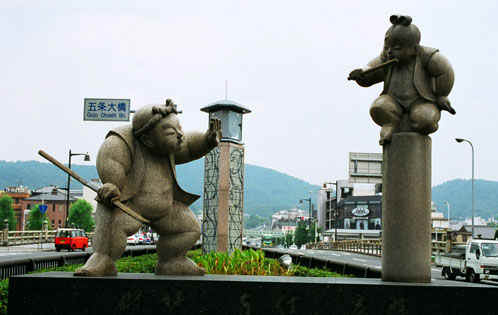Saitō
Musashibō Benkei (西塔武蔵坊弁慶,
1155–1189), popularly called Benkei, was a Japanese warrior monk (sōhei)
who served Minamoto no Yoshitsune. He is commonly depicted as a man of great
strength and loyalty, and a popular subject of Japanese folklore. His life has
been embellished and distorted by kabuki and Noh drama, so that truth cannot be
distinguished from legend.
Minamoto
no Yoshitsune (源 義経,
1159 – June 15, 1189?) was a general of the Minamoto clan of Japan in the late
Heian and early Kamakura period. Yoshitsune was the ninth son of Minamoto no
Yoshitomo. Yoshitsune’s older brother Minamoto no Yoritomo (the third son of
Yoshitomo) founded

Statues depicting the fight between
Yoshitsune and Benkei at Gojo Ohashi, in Gojodori (Gojo Street)
the
Kamakura shogunate. Yoshitsune’s name in childhood was Ushiwakamaru (牛若丸).
Stories
about Benkei’s birth vary considerably. One tells how his father was the head
of a temple shrine who had raped his mother, the daughter of a blacksmith.
Another sees him as the offspring of a temple god. Many give him the attributes
of a demon, a monster child with wild hair and long teeth. In his youth Benkei
may have been called Oniwaka (鬼若?)
— ”demon/ogre child”, and there are many famous Ukiyo-e works themed on
‘Oniwakamaru’ and his adventures.
He
joined the cloister at an early age and traveled widely among the monasteries of
Japan. During this period, the Buddhist monasteries of Japan were important
centers of administration and culture, but also military powers in their own
right. Like many other monks, Benkei was probably trained in the use of the
naginata. At the age of seventeen, he was said to have been over two meters (or
6.6 feet) tall. At this point he left the Buddhist monastery and became a
yamabushi, a sect of mountain monks, who were recognized by their black caps.
Japanese prints often show Benkei wearing this cap.
Benkei
is said to have posted himself at Gōjō Bridge in Kyoto, where he
deprived every passing swordsman of his weapon, eventually collecting 999
swords. On his 1000th duel, Benkei was defeated by Ushiwakamaru (Minamoto no
Yoshitsune). Henceforth, he became a retainer of Ushiwakamaru and fought with
him in the Genpei War against the Taira clan. Ushiwakamaru is credited with most
of the Minamoto clan’s successes against the Taira, especially the final naval
battle of Dannoura.
During
the two-year ordeal that followed, Benkei accompanied Ushiwakamaru as an outlaw.
In the end they were encircled in the castle of Koromogawa no Tate. As
Yoshitsune retired to the inner keep of the castle to commit ritual suicide
(seppuku) on his own, Benkei fought on at the bridge in front of the main gate
to protect Yoshitsune. It is said that the soldiers were afraid to traverse the
bridge to confront him, and all that did met swift death at the hands of the
gigantic man. Long after the battle should have been over, the soldiers noticed
that the arrow-riddled, wound-covered Benkei was standing still. When the
soldiers dared to cross the bridge and look more closely, the giant fell to the
ground, having been dead in a standing position for some time before that. This
is known as the “Standing Death of Benkei” (弁慶の立往生,
Benkei no Tachi Ōjō).
It
is Benkei’s loyalty and honor that makes him most attractive in Japanese
folklore. One kabuki play places Benkei in a moral dilemma, caught between lying
and protecting his lord in order to cross a bridge. The critical moment of the
drama is its climax, where the monk realizes his situation and vows to do what
he must. In another play, Benkei even slays his own child to save the daughter
of a lord. In the kabuki play Kanjinchō, filmed by Akira Kurosawa as The
Men Who Tread on the Tiger’s Tail, Benkei must beat his own master (disguised
as a porter) in order to avoid breaking his disguise.